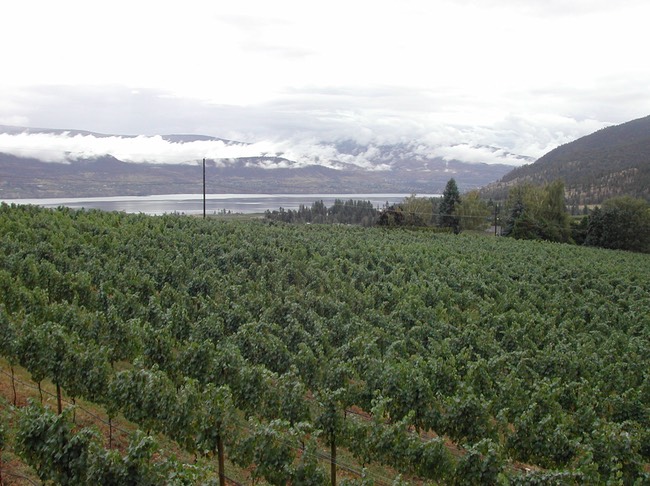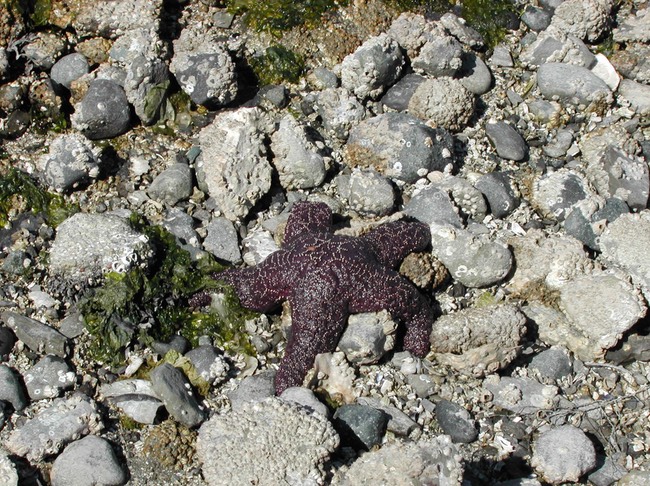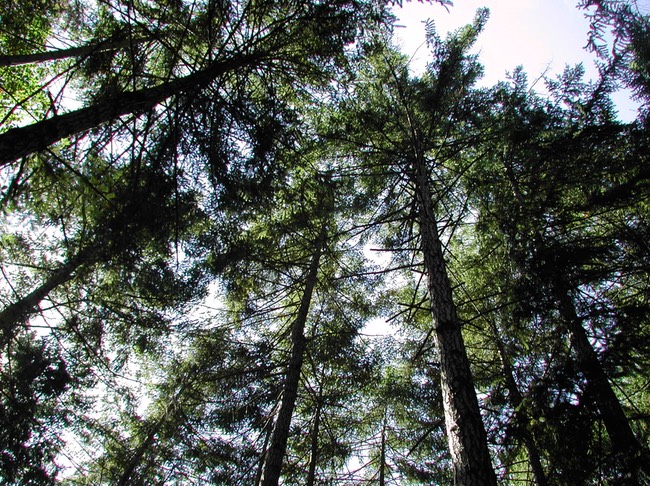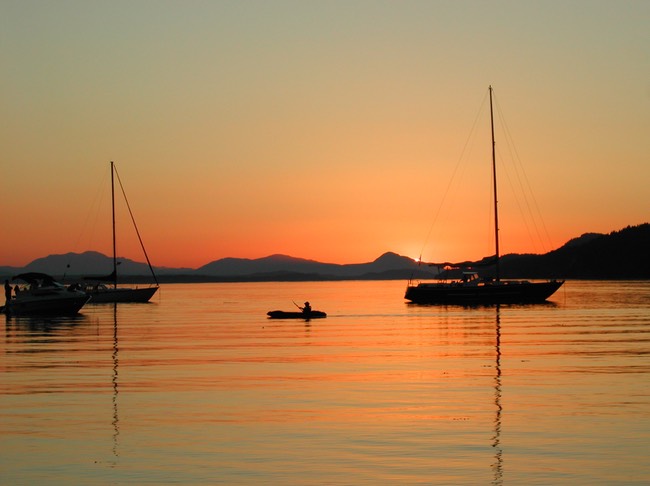
We set out from Galiano Island on the late afternoon ferry. We have spent three days there, hot midsummer days, during which relief from the baking heat was found walking through the trees, admiring the lazy sweep of the cedar branches and the twisting, peeling trunks of the red-brown arbutus, or by plunging into the salt chill of the ocean. Out in the harbour, the sailboats looked cool and inviting, but we knew that they, unshaded by any tree, were even hotter than our campsite; until dusk, when the cool air followed the fading of the orange and purple sunset.

Galiano encompasses the essence of the west coast. On its beaches, long spits of sandstone emerge from the ebb tide, dotted with tide pools teeming with life, and shells crunch continually underfoot as we hunt for treasures. Expanses of wet sand spout jets of water as the clams burrow beneath. The dark purple sea stars, the red and orange crabs, the translucent jelly fish, the waving tentacles of the sea anemones, the green and brown of the seaweed, all decorate the shore. Above the beach, seagulls swoop and eagles soar, while behind us, the forest touches the shoreline, with the dusty green of the conifers interspersed by the exotic colours and shapes of the arbutus trees. The graceful herons hunt along the tide line, and seals and sea otters playfully explore the bay.

We leave this coastal paradise behind, and the ferry speeds us to the mainland, and the flat lowlands of the Fraser delta. Driving through the delta and along the Fraser Valley, we are surrounded by the sprawl of the city– subdivisions climbing up the mountainsides to the north, strip malls and big box stores along the highway. But gradually, the car dealerships give way to the renters of farm equipment, and the subdivisions to the farms themselves: blueberries, raspberries, and further east, long expanses of gently waving corn; cattle at pasture, occasional horses, and the modest houses and run-down barns of the small farming families. Around Chilliwack, the mountains, which have been rising higher to the north, begin to close in about us, and we are truly driving through them by the time we reach the town of Hope, at the confluence of the Fraser and Coquihalla Rivers.
These coastal mountains are green and dramatic, with well-defined peaks above the tree line, and the lush green forests surrounding us. There are many kinds of trees, both deciduous and coniferous, and the multiple shades of green make a rich, fertile impression. Long ago, the rivers cut the first path through these mountains, followed much later by the railway, and more recently the highway. As we drive, we watch the long freight trains snaking slowly along the water. Past Hope, as we take Highway 5 along the Coquihalla River, the mountains continue to dominate. The forests are dense and dramatic, with evergreens dominating as we continue east. We begin to see here and there the depredations of the mountain pine beetle, in the brilliant oranges and purples of dying trees.

As we approach Merritt, the trees become thinner, finally disappearing in favour of dramatic rock faces and hills of bleached yellow grass. At Merritt, we leave Highway 5 for the Okanagan connector highway, 97c, where the mountains settle into a series of vistas that roll continually away into the distance, carpeted with dark green forest. The hues fade as the eye travels farther away, from deep green to dark blue, from dark grey to pale blue in the distance. There is a sense here of the limitless size of this western land, a feeling that beyond what the eye can see, the forests will continue on endlessly.
As we look along the road ahead, suddenly a space opens up that reveals an entirely different landscape. Just beyond the tree covered mountains is a mountainside that is not green, but brown and umber, almost golden in comparison to the forests through which we now pass. To us, this is a glimpse of a familiar world, and we know that we have almost reached the dry, desert-like terrain of the Okanagan Valley.
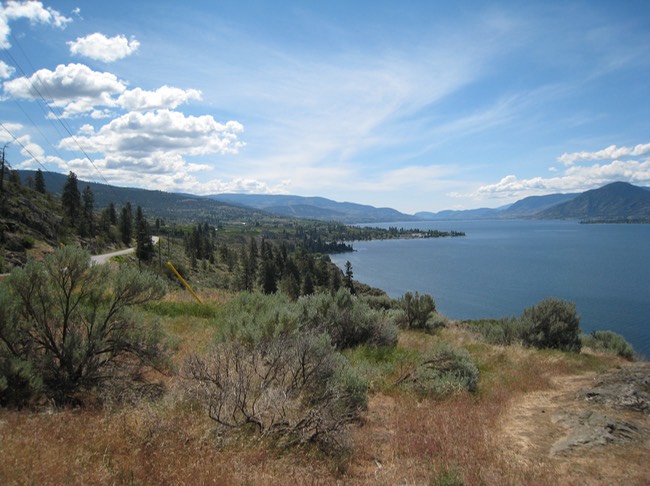
Emerging from the forest, high on the mountainside, a vista is revealed to us. The sparkling blue of Okanagan Lake, with the hills of rock, grass, and tumbleweed rising behind it. Sailboats and whitecaps dot the water far below us, and we sail down from the mountains to join Highway 97, which snakes along the edge of the lake all the way to Penticton.
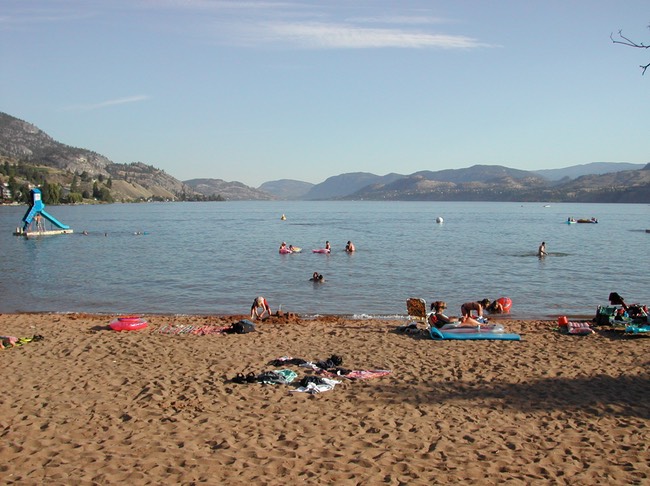
We have moved into another world, a vacation paradise of water and sun, of tumbleweeds, grapevines, and fruit trees, of beaches and golf courses. It is hard to believe that this world exists side by side with the remote, unpopulated mountains, and is a mere four hours’ drive from the coastal rainforest and the tidal pools.
Photos: sea star on the beach, Galiano Island; a kayak passes between sailboats at Montague Harbour; Arbutus trees line the coast; towering Douglas firs on Galiano; mountains near Hope; Okanagan Connector; Okanagan Lake; Skaha Lake; vineyard above Okanagan Lake
